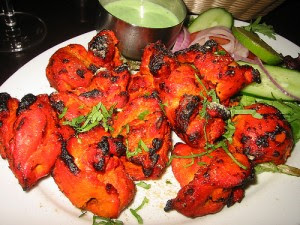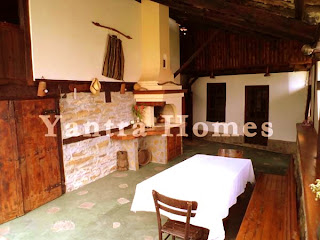When you buy an old village
house in Bulgaria you will often see that it has an earthen oven in the garden or outhouse.
However, they are often damaged and need repairing or even re-building!
Familiar site? Have you ever thought how this can be done?
Well read on and learn how you will be the earthen oven maestro of the village in the
Veliko Tarnovo region, you chose to live in, here in Bulgaria.
An oven is just a hole in the ground – light a fire, heat it up, and bake! An earthen oven is about that complicated. If you made mud pies when you were a kid, you can make a beautiful mud oven. You can also do it for nothing (or next to it), and it will work as well as a custom-built masonry or ceramic model costing thousands.
Earth is not only more common, safe, cheap, and easier than brick, it’s also more environmentally friendly and, I think, beautiful.
The three basic steps to oven-making are:
Make a pile of damp sand, and pat into a hemisphere.
Cover with a layer or three of mud.
Cut out a doorway and remove the sand.
If you fire-dry it, you can bake tomorrow. To bake, fire the oven without a door cover. Then clean out the fire and load your loaves or meat or veg into the hot oven, put something in front of the door, and wash your hands for supper.
 |
| Dilapidated clay oven, but don't despair |
Details:
The floor: brick is a common choice – new, old, red brick, or firebrick.
The mud: In most places, there is clay subsoil below the topsoil. Like cement, clay holds things together. If you have a garden, you likely have good soil for building. Use it straight out of the ground, or mix it with sand. If you have no garden, anyone digging a hole will probably give you some.
The base, or foundation: You can spend lots of time (and money) on a magnificent stone foundation. Or build on the ground, on a pile of rocks, on logs or railroad ties, old metal barrels, or even on sawhorses.
Protection from the elements: A roof is nice, but not necessary. It takes a long time for an oven to ‘wash away in the rain’ (look how long the hills last…). But a wet oven takes longer to heat up. So cover it with a tarpaulin or bend pieces of roofing tin into a vault for a simple, elegant, and cheap solution. DON’T USE PAINT OR CEMENT! An earthen oven, like a living thing, breathes. When baking, it ‘exhales’ steam. Cement or paint will trap moisture and destroy your oven.
Tools & Materials
Water
Dirt (subsoil)
Sand to mix with mud: ‘sharp’(not rounded or beach) sand is best
Material for the oven form: sand,or anything that will make a firm, but removable form (topsoil, chunks of turf, etc.)
Firebricks or standard red bricks, new or used, free of old mortar
Wood for a baking door
Newspaper
Shovel
Wheelbarrow
20 litre (5 gallon) plastic buckets
Tape measure
Tarps: 2×2.5m (6x8ft) minimum.
Spoons, spatulas, dull knives, etc., in case you want to do any sculpting
Timber scraps
Old clothes to get dirty in, and boots if you don’t want to go barefoot
Spirit level, two or four foot (optional)
Your oven can be one or more layers thick. Here we’ll just describe a single layer, to give you the idea. It’s easy to extrapolate and improvise.
Finding Clay Subsoil
Clay subsoil is pretty easy to recognize. I take a pinch of dirt in my palm, spit into it, and mix it with a finger. Silt or organic matter feels floury or crumbly. Clay feels sticky, slippery, and a bit greasy. Wetted, it rolls into snakes between your palms and wraps around your finger. (Beware dirt that may contain glass or debris; ask permission where necessary.)
When dry, the clay should be hard, not crumbly. Test it. Make bricks and let them dry. See how much they crack and how hard they are. Try mixing dirt with sand, and make more bricks. If they show less cracking and shrinkage, good! Compare and choose the best. Remember what your proportions were.
Your Oven Floor
The simplest and easiest thing to do is simply to set your floor bricks in a 10-15cm (4-6in) bed of sand, tamped and smoothed into an even, level bed. No mortar is necessary. The bricks will be held in place by the heavy, solid oven walls.
Set your first brick carefully, level and solid. The more even and flat your bricks, the easier you’ll be able to clean it. Hold the next brick level and about 2.5cm (1in) above the sand; gently ‘kiss’ its long side to the match-ing side of the previous one. Set it flat and firm on the sand. Don’t wiggle it! Minimize cracks and gaps. When they’re all down, set them lightly with a hammer handle. If one stands up a bit proud, tap it down.
Make A Sand Form – Shape The Void
The sand form is the shape of the void. Sand (or whatever) should be moist enough to pack into a ball, but not so wet that it slumps. Make a pile on the floor bricks. Make the walls near vertical at first, to give your loaves ‘head room’.
The form should be a bit higher than the radius of the oven floor. Too high, and you get cooling eddies at the top of the dome; too low, and the fire won’t get enough air. A 69cm (27in) diameter oven, with a 34cm (13in) radius, should be 40-50cm (16-20in) high.
Hold a straight stick level across the top; measure the distance to the floor to get the interior height of your oven. Multiply it by 63% (0.63) to determine the proper height for your oven door. Write down the number!
Mix Mud
Use whatever mixture gave you the best, hardest, strongest test bricks. Prepare a pile of dry mix on your tarp. (If you’re using pure subsoil, you may need to do nothing, or just add a little water so it’s moist enough to build with.)
With two people, hold two corners of the tarp each – feet spread, knees bent, elbows down and shoulders back – roll the mix from side to side. Don’t lift! You can do this solo by pulling one end of the tarp over the other, rolling as you go. A longer tarp is easier. Or just use bare hands and feet and muck around in it.
Add water slowly. Take off your shoes, jump in, and do the twist – seriously! As you twist and turn, your feet work like rotating pistons, breaking up the clay and pressing sand into it. Play music! Grab a partner! Dance ’til it starts to clump, like dough for pie crust.
Test it. Pack a hard ball (50-100 pats from hand to hand). Drop it from breast height. It should hold together. If not, add a little water. If it’s too wet; add dry mix (harder), or use as is and allow more drying time (easier).
Build!
First, cover your sand form with sheets of wet newspaper (so that later, you’ll know where the void ends and the oven begins). Smooth them down flat. Press handfuls of your mix around the base of your sand form. Use your fingers as a gauge to guide you in maintaining thickness. Make a layer at least three inches thick. You can make it thicker (it will hold more heat), but a thicker oven also requires more fuel.
Maintain a well-defined edge. As you go higher, the face of the layer should angle upwards. Cover the whole form, even where the door will go (you’ll cut it out later). When it’s all covered, take a flat board and pack the material ’til solid. If it squishes and/or sticks to the board, don’t worry! Your mix was too damp. Rock the board firmly back and forth, up and down, or rub it as if you were polishing. Make it beautiful.
Say your dome is 45.5cm (18 in) high (interior height). Your door should be 0.63×45.5=28.7cm 0.63×18=11in) high. As for width, 30-50% of the inner diameter is good.
Scratch a line in the material where the door will be. Cut a hole just big enough to get your hand in. Dig a narrow channel into the form. If the mix was moist but not wet, you can dig out the whole form immediately. If, when you poke the thermal layer with a finger, it’s firm and resists denting, go on and dig. If it’s soft, or you’re in doubt, wait and let it dry (this can take days or weeks depending on the weather)!
When you remove the sand, watch for the newspaper so you know you’re not digging away the oven. Refine the doorway so it’s smooth and even.
You’re Done!
Air drying the finished oven can take weeks, but if you’re impatient to bake, make a small fire in the oven to speed up the process. Even when they’re not quick-dried, they may crack. If so, don’t worry. Cracking due to natural expansion invariably occurs during firing. If the cracks don’t close when the oven is cool, you can fill them (from the outside) with mud.
When I’ve built a quick oven and heated it up in a hurry, I’ve sometimes sealed it with bricks and sand, or whatever else I could get my hands on. It doesn’t even need to fit perfectly, since you’ll drape it with a wet cloth to keep it from charring and to add steam for baking. You can also soak it in water, or screw a sheet of metal to the inside, or wrap it in foil.
You are now ready to fire up your oven, and bake in the garden of your
Bulgarian property. The aroma of your cooking will be floating around the neighbouring regions of Veliko Tarnovo proving that the old Bulgarian way is the best way to cook either your bread or your lamb, or be adventurous like me and try cooking tandoori chicken or pork loin tikka and bring a bit of India into the Country!
delicious tandoori chicken in Bulgaria?
Kiko Denzer is from Oregon, USA. He is a sculptor and builder who has been working with cob and earthen materials for 8 years. He has taught in Mexico and Canada, as well as the US, and often with his wife, Hannah Field, who was a baker at the Village Bakery in Cumbria.
Build Your Own Earth Oven, by Kiko Denzer is available from the Green Shopping Catalogue.
Source of this information http://www.permaculture.co.uk/articles/simple-art-making-earth-oven








